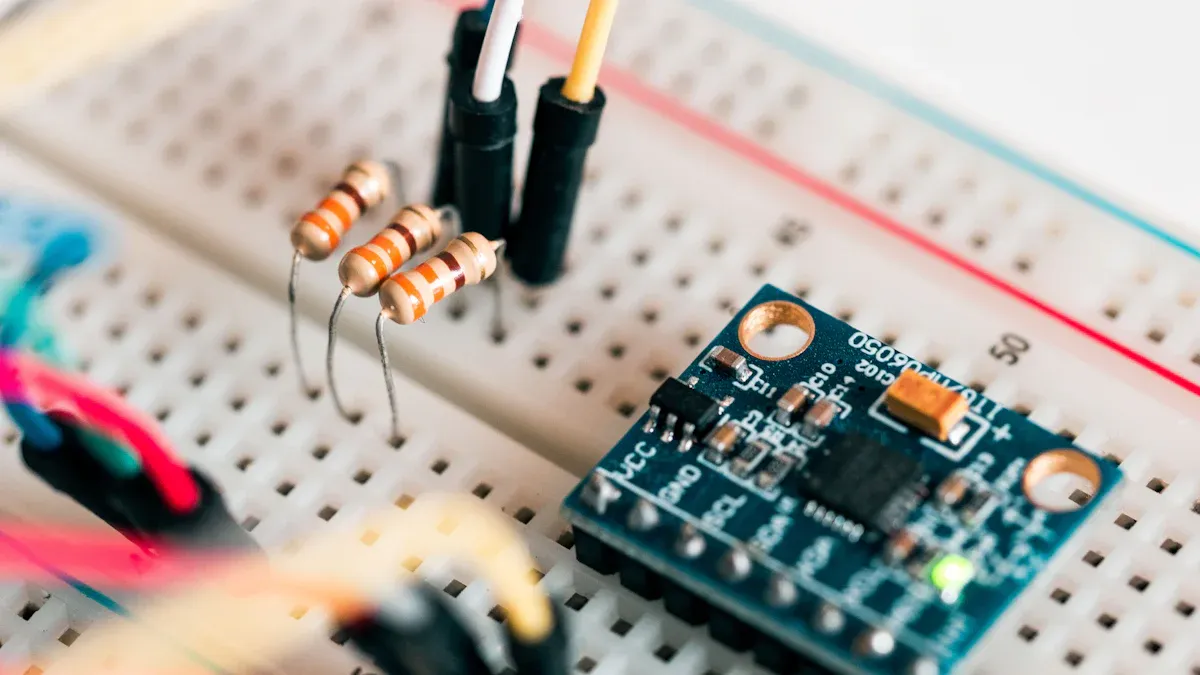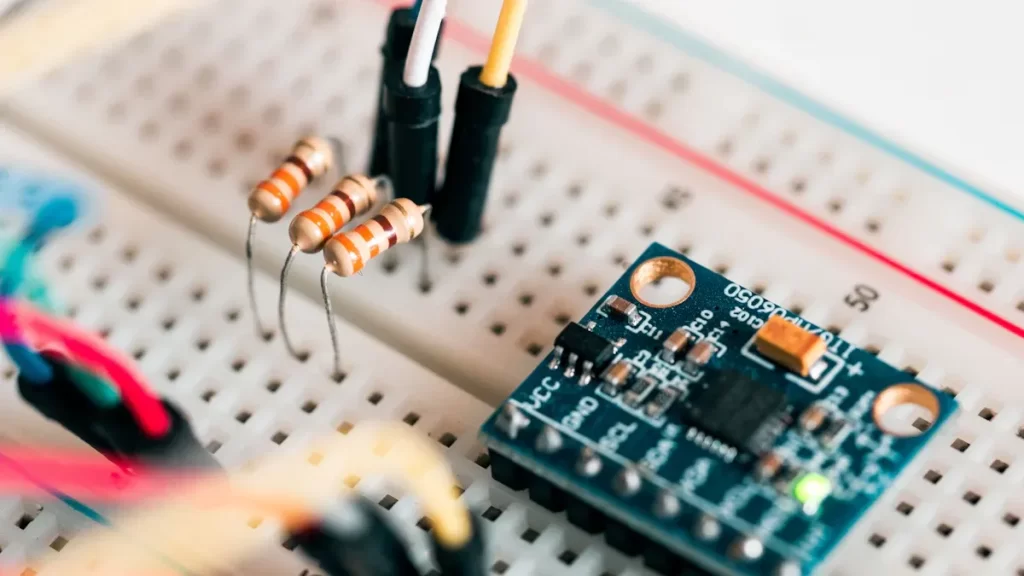
Through-hole technology is still very important in electronics. It is strong and reliable, making it a top choice. Unlike surface-mount technology, it connects parts by putting them through circuit boards. This makes the connection very strong, even if it faces pressure.
Strong connections help parts handle shaking and sudden impacts.
It works well for systems that need a lot of power.
Parts can survive tough conditions, like in space or the military.
Its sturdy design is great for systems needing strong support.
As electronics improve, through-hole technology stays useful in tough jobs, showing its worth in 2025.
Key Takeaways
Through-hole technology makes strong links, great for tough places like cars and planes.
It holds big parts well, keeping medical tools and machines steady and safe.
These parts are simple to use and swap, good for testing and building projects.
Mixing through-hole and surface-mount tech makes strong and smart electronics.
Using through-hole tech helps devices last long in hard and rough conditions.
Advantages of Through-Hole Technology
Toughness in Hard Conditions
Through-hole tech is great for tough environments. Parts are placed into holes on the circuit board, making strong connections. This works well in places with lots of shaking or movement, like cars and planes. For example:
Car electronics use it to handle engine shaking.
Planes rely on it during turbulence or fast speeds.
These parts stay strong over time, even in harsh places. That’s why industries needing dependable systems often choose through-hole tech.
Strong Support for Big Parts
Big parts, like transformers or capacitors, need solid support. Through-hole tech gives this by soldering parts through the board and securing them underneath. Studies show through-hole parts, like DIP components, are stronger than surface-mount ones. This makes them perfect for machines that face stress or shaking.
For example, factory machines have big parts that move a lot. Through-hole tech keeps these parts steady, lowering failure risks and helping machines last longer.
Dependability in Critical Systems
Important systems need parts that handle high power and stay strong. Through-hole tech is great for these jobs, making it a trusted pick for safety systems. Examples include jet engines, radar, and medical tools like MRI machines.
Where It’s Used | Examples |
|---|---|
Planes and Defense | Avionics, radar systems |
Cars | Engine controls, LED lights |
Medical Tools | MRI machines, monitors |
These systems work in tough spots where failure isn’t allowed. Through-hole parts, with their strength and power abilities, keep them working reliably.
Compatibility with Prototyping and Testing
Through-hole technology is very helpful for testing and prototyping. When creating new designs, you need parts that are easy to use. Through-hole components are simple to handle because they are bigger and accessible.
Unlike surface-mount parts, through-hole ones are larger and easier to manage. This makes them great for breadboards and testing setups. You can add or remove parts quickly without special tools. For example:
Engineers use through-hole resistors and capacitors to test circuits.
Students like these parts because they are easy to work with.
Tip: Use through-hole parts for prototypes to make changes easily.
Through-hole technology also helps with fixing problems. If a circuit fails, you can check and replace broken parts easily. The visible leads and connections make it simple to follow the electricity flow. This saves time and ensures your design works properly.
Feature | Benefit for Prototyping |
|---|---|
Bigger component size | Easier to handle and change |
Visible connections | Makes fixing problems easier |
Reusable parts | Saves money during experiments |
Through-hole parts are also strong. They can handle being added and removed many times. This makes them perfect for testing again and again. Whether you’re an engineer or a hobbyist, these parts stay reliable during development.
Through-hole technology lets you build, test, and improve ideas confidently. Its usefulness in prototyping and testing makes it a key tool for creating new things.
Evolution and Uses of Through-Hole Technology
Moving from Old Systems to Mixed Designs
Through-hole technology might seem old, but it still improves. Many older machines use it because it works well. Today, new electronics mix through-hole parts with modern ones. This mix gives the best of both styles. For example, industries like defense and aerospace upgrade old systems. They add surface-mount parts but keep through-hole ones for important tasks. This keeps systems strong while adding new features.
Using mixed designs lets you enjoy both technologies. Through-hole parts are strong, and surface-mount ones are small. This mix is great for updating old machines to meet today’s needs.
Working with Surface-Mount Technology (SMT)
Through-hole and SMT work together, not against each other. SMT is good for small, light parts. Through-hole is better for big, tough parts. For example, cars use SMT for sensors and chips. They use through-hole parts for power systems and connectors.
This teamwork helps make strong and useful systems. By combining them, you can build products that are small but tough. This is common in robotics, where machines must be light but handle lots of movement.
Better Materials and Manufacturing
Through-hole materials are much better now. New soldering methods and alloys make parts stronger. These parts can handle heat and shaking better than before.
Making through-hole parts is also more exact now. Machines place and solder parts perfectly, lowering mistakes. These changes make through-hole parts great for hard jobs. Whether for factory machines or medical tools, these upgrades make them work better and last longer.
Top Applications of Thru-Hole Technology in 2025
Aerospace and Defense Systems
Thru-hole technology is key in aerospace and defense. These fields need parts that survive tough conditions like high altitudes, fast temperature changes, and strong vibrations. Thru-hole parts are used in avionics, radar systems, and satellites. Their strength keeps them secure during turbulence or rocket launches.
For instance, radar systems use thru-hole parts for power and signals. These parts handle high currents and voltages, making them perfect for critical tasks. Thru-hole technology’s toughness ensures these systems work well, even in harsh environments.
Automotive Electronics for Safety and Power
Cars need parts that handle heat and stress. Thru-hole technology is great for this. It’s strong and handles heat well, making it ideal for engine controls and power steering.
Thru-hole parts handle high voltage and current for modern cars.
They prevent failures, keeping safety systems like airbags reliable.
Electric cars also use thru-hole parts for power circuits and chargers. Their strong design ensures they last, even with heavy use.
Medical Devices Requiring High Reliability
Medical devices must work perfectly to keep patients safe. Thru-hole technology is trusted because it’s strong and reliable. Machines like MRI scanners, heart monitors, and pumps use these parts for important systems.
Thru-hole parts have strong bonds, resisting wear and tear. This is vital for devices that run nonstop or need frequent cleaning. Thru-hole technology ensures these machines stay accurate and safe, even after years of use.
Note: Thru-hole parts are crucial for life-saving medical tools.
Industrial Machinery and Heavy Equipment
Big machines need parts that handle tough conditions. These machines often face strong vibrations, high heat, and heavy stress. Thru-hole technology helps keep these systems working well and lasting long.
For example, factory robots and conveyor belts use big parts like transformers. These parts must stay secure during nonstop work. Thru-hole technology keeps them steady by attaching them firmly to the circuit board. This lowers the chance of breaking, even under heavy use.
Another benefit is how thru-hole components manage high power. Big machines need circuits that handle lots of electricity. Thru-hole technology is great for this, making it perfect for power supplies and motor controls.
Tip: Use thru-hole components for important parts in heavy machines. They last longer and work better under stress.
Consumer Electronics with High Durability Needs
Durability is important for gadgets, not just how they look. Devices like tough phones, outdoor speakers, and gaming consoles need to survive daily use. Thru-hole technology makes these products stronger.
Outdoor gadgets often use thru-hole components. These parts resist damage from drops, shaking, and temperature changes. For example, portable speakers with thru-hole connectors still work after being used in rough conditions.
Gaming consoles also gain from thru-hole technology. Parts like power connectors stay in place, keeping the console reliable. This is key for gamers who play for hours without stopping.
By using thru-hole technology, companies make gadgets that last longer and work better, even in tough situations.
Industry Trends Supporting Through-Hole Technology
Need for Tough Electronics
Industries want electronics that survive tough conditions. Rugged electronics are needed in aerospace, defense, and factories. These places have lots of shaking, heat changes, and stress. Through-hole technology helps because it makes strong connections.
For example:
Airplane systems use through-hole components to handle turbulence.
Factory robots rely on them to stay steady during work.
Using through-hole technology keeps systems strong and reliable, even in hard conditions.
Tip: Use through-hole components for important parts in rough environments.
Growth of IoT in Tough Places
IoT devices are now used in hard places like factories and oil rigs. These devices face dust, water, and extreme heat. Through-hole technology makes them last longer and work better.
For example:
IoT sensors in factories use through-hole parts for power and connections.
Outdoor devices, like weather stations, benefit from their strong design.
Adding through-hole technology to IoT devices helps them survive and perform well in tough spots.
Demand for Long-Lasting Parts in Key Systems
Important systems need parts that last a long time. These include medical tools, airplanes, and defense systems. Through-hole technology is great for these jobs. It handles high power and tough conditions.
Airplanes and defense systems use through-hole parts for durability.
Medical machines, like MRI scanners, depend on them to work nonstop.
Power systems need through-hole components for handling high electricity levels.
Through-hole technology keeps critical systems working safely and reliably. It’s the best choice for jobs where failure isn’t an option.
Through-hole technology is still very important in 2025 electronics. It is strong and dependable, making it useful for industries like aerospace, cars, and medical tools. It works well in systems that need to handle tough conditions.
Key Takeaway: Through-hole parts are best for strength and lasting use.
In the future, better materials and mixed designs will make it even more useful. By using it with new technologies, you can solve modern problems. Through-hole technology keeps showing how important it is for the future of electronics.
FAQ
What is through-hole technology?
Through-hole technology means putting electronic parts into holes on a circuit board. The leads are soldered on the other side, making strong connections. This method works well for jobs needing strength and dependability.
Why is through-hole technology still important in 2025?
Through-hole technology is vital for fields like aerospace, cars, and medical tools. It offers great strength, dependability, and handles high power. These features make it perfect for tough jobs and harsh places.
Can through-hole parts work with surface-mount technology (SMT)?
Yes, through-hole and SMT parts can be used together. Through-hole parts are good for big, tough components. SMT works best for small, light parts. Together, they make strong and efficient systems.
Are through-hole parts better for testing?
Yes! Through-hole parts are bigger and easier to use. You can add or remove them quickly during testing without special tools. This makes them great for building and fixing circuits.
Which industries use through-hole technology the most?
Industries like aerospace, defense, cars, medical tools, and factories use through-hole technology a lot. Its strength and dependability make it ideal for systems that need to last or handle tough conditions.
Tip: Choose through-hole parts for projects needing strength and long-lasting performance.
See Also
Choosing The Right PCB Assembly Method: SMT Or Through-Hole
Discover The Impact Of AI On Modern PCBA Techniques
Achieving High-Quality Results Through PCBA Manufacturing Mastery





